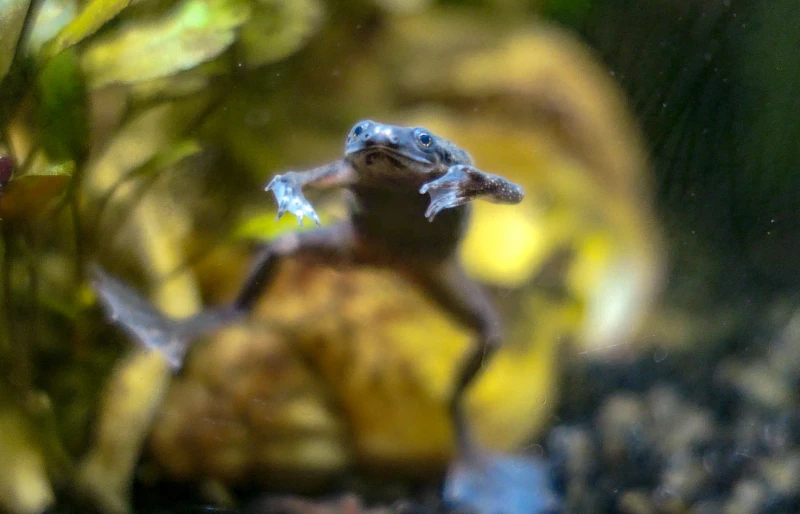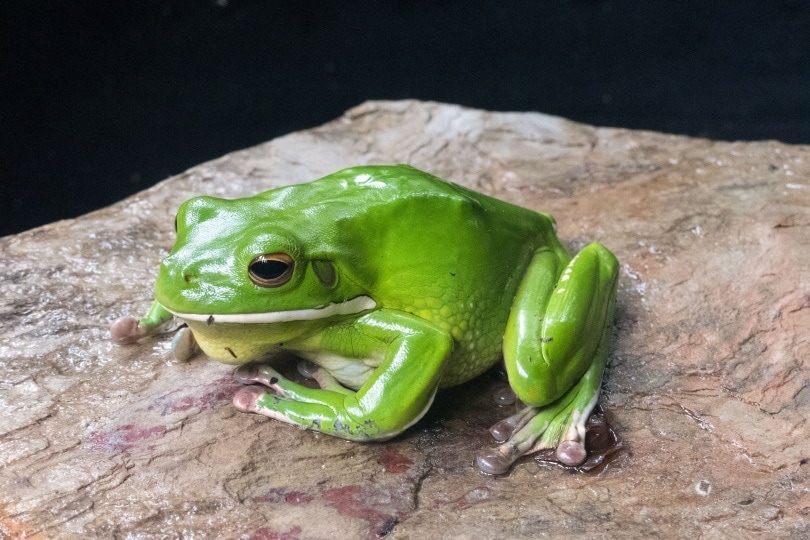How to Set Up a Pacman Frog Enclosure: 4 Important Tips
Updated on
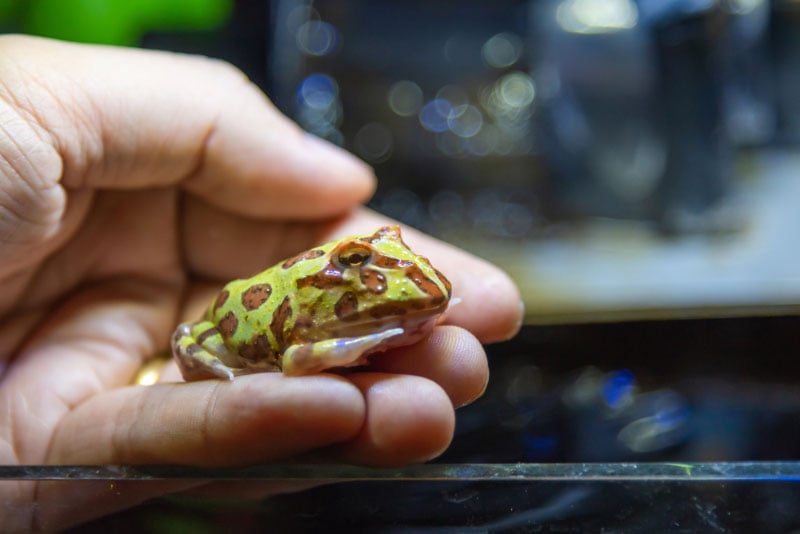
The South American Horned Frog, also commonly known as the Pacman Frog, is a goofy-looking and surprisingly chilled-out amphibian companion, ideal for first-time reptile or amphibian owners. They don’t have a lot of expensive or special needs, but they do have some unique requirements you should be aware of before setting up your frog’s habitat. Let’s break down exactly what you need to set up the perfect Pacman Frog enclosure, and how to go about it, step-by-step.

Before You Begin
Reptiles and amphibians require more equipment for their initial setup than cats and dogs but are more low maintenance over time. Let’s walk through all the gear you need to get started with your brand-new Pacman Frog today.
- 10–20-gallon tank
- Substrate (coconut coir, soil, moss, etc.)
- Heat lamp/under-tank heater
- Thermometer & hygrometer (for measuring temperature & humidity)
- Wide, shallow water dish
- Vitamin D3 supplement powder
- Natural hiding places (rocks, branches, cork, etc.)
The 4 Tips on How to Set Up a Pacman Frog Enclosure
1. Selecting the Right Tank for Your Frog
Male Pacman Frogs do great in a 10-gallon tank, while the larger females may require up to 20 gallons to have enough space. However, it’s worth noting that although Pacman Frogs spend most of their time burrowed in the tank’s substrate, you should still be providing a habitat large enough for them to comfortably move around in. Look for tanks with side doors, as the standard top-opening tanks are hard to clean out and add new substrate to. We also always recommend a lockable door when buying a new tank to keep your frog safe.
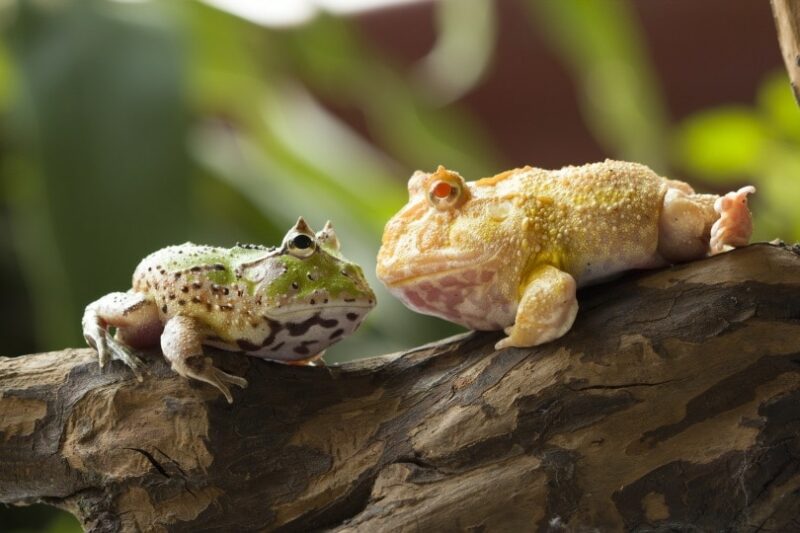
2. Choosing Substrate & Adding Hides
Pacman Frogs spend most of their time digging and burrowing in their tank’s substrate, and there are several good options to choose from. Let’s briefly review the most common substrates you can use and a bit about each one.
- Coconut coir: New and economical, coco coir, a by-product of harvesting coconuts, holds moisture very well and doesn’t contain any chemicals or pesticides.
- Potting soil: The classic choice, Pacman Frogs love burrowing in fresh soil, but make sure you choose a sterile mix with no harmful chemicals!
- Peat moss: Moss is a solid substrate choice but difficult to source in bulk, so we suggest mixing it with another substrate to keep your frog interested.
- Leaf litter: Partially decomposed leaf matter makes a great alternative to soil that holds moisture very well but needs to be replaced more frequently.
Once you have your chosen substrate, it’s time to spread it all over the bottom of your enclosure. You want to pile it at least 3 inches high so your frog can burrow satisfactorily. This substrate should be sifted every few days and changed weekly to biweekly.
Don’t forget to add live plants, branches, and hides for your frog once you’ve got the substrate in. This allows them to climb or hide at their leisure – making their environment interesting.
3. Light & Temperature Setup
Unlike other reptiles and amphibians, the Pacman Frog doesn’t strictly require a UVB light to stay healthy. You can skip the UVB light if you’re regularly feeding your frog vitamin D3, but you’ll still need a heat lamp. Pacman Frogs prefer temperatures from 75°F to 85°F and need a day/night cycle to regulate their hormones, metabolism, circadian rhythm, and more. Keep an eye on the temperature, and aim for 10–12 hours of fluorescent light per day.
If you’re not feeding your frog vitamin D3, you’ll need a UVB bulb to help your frog synthesize this essential nutrient. It may still be worth looking into supplements considering the time they spend buried, though.
Pacman Frogs love moisture and prefer a humidity range of 60% to 80% in their enclosures. Monitor this by putting a hygrometer on the side inside the tank. You can help maintain this by keeping a shallow dish of clean water for your frog to soak and periodically misting the substrate. Ideally, you want to keep it persistently damp but never totally dry or soaking wet.
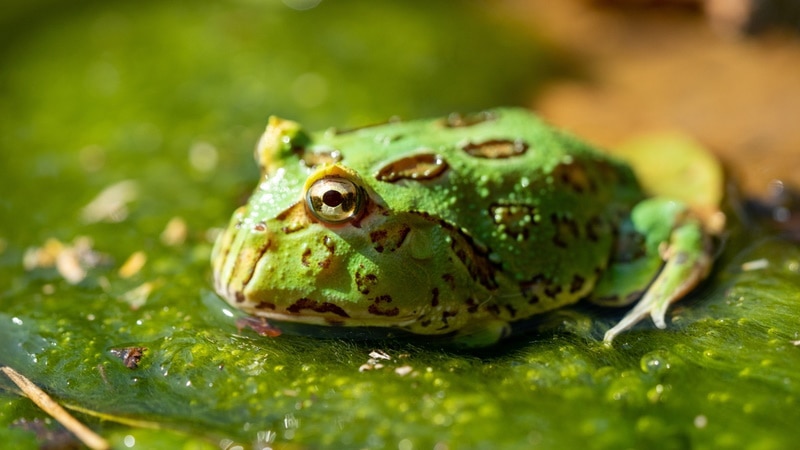
4. Pacman Frog Diet
Pacman Frogs are voracious eaters with a preference for crickets, dubia roaches, mealworms, minnows, tadpoles, and occasionally, even a whole mouse. Simply put, they’re not picky eaters!
But what about their optimal diet in captivity? Mostly gut-loaded or recently fed crickets frequently swapped out with any of those other offerings above. Dubia roaches are our favorite recommendation because of their very high protein content. Small fish are also healthy choices that can add some variety to the diet—minnows and goldfish are both acceptable.

Final Thoughts
Pacman Frogs have a distinctive look, an ultra-chill personality, and aren’t fussy eaters. The initial setup is a little tricky, requiring you to monitor the temperature and humidity, but we think the Pacman Frog is a perfect choice for anyone who would like to enter the world of amphibian keeping.
Featured Image Credit: BLUR LIFE 1975, Shutterstock

